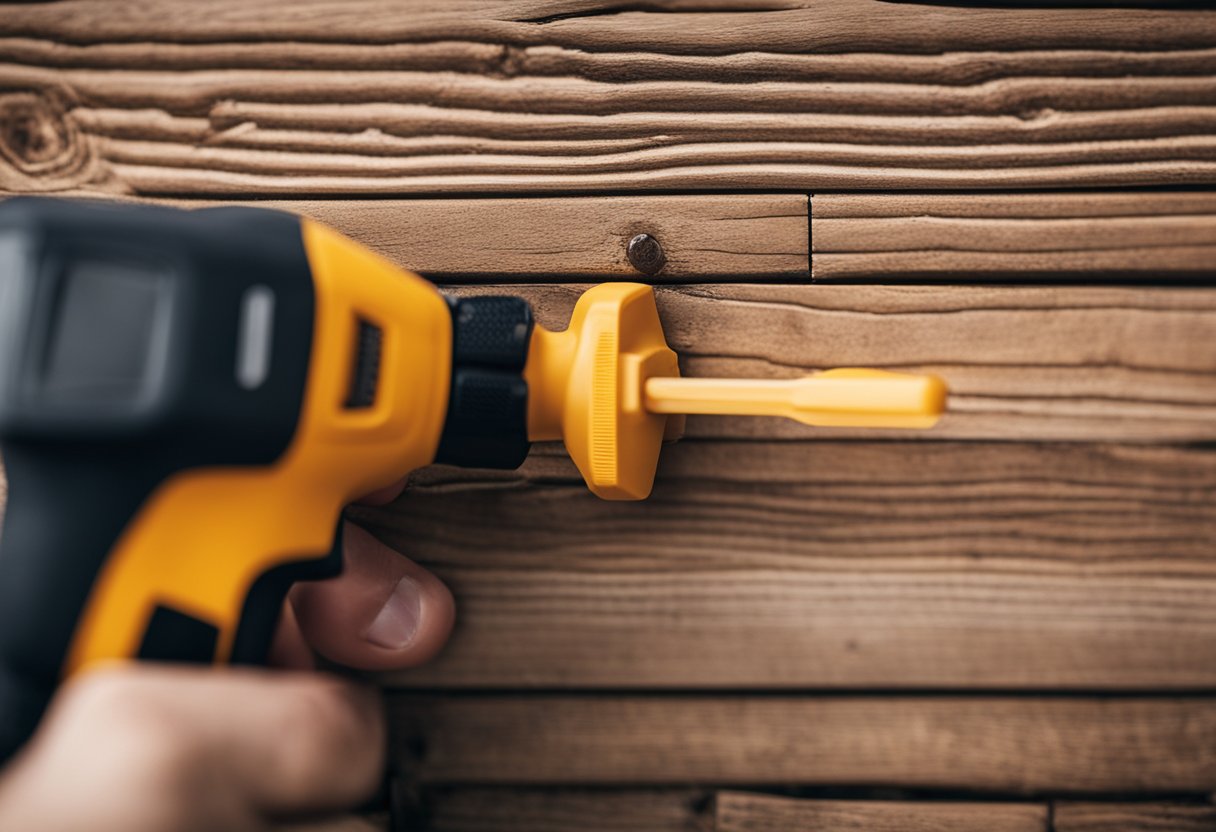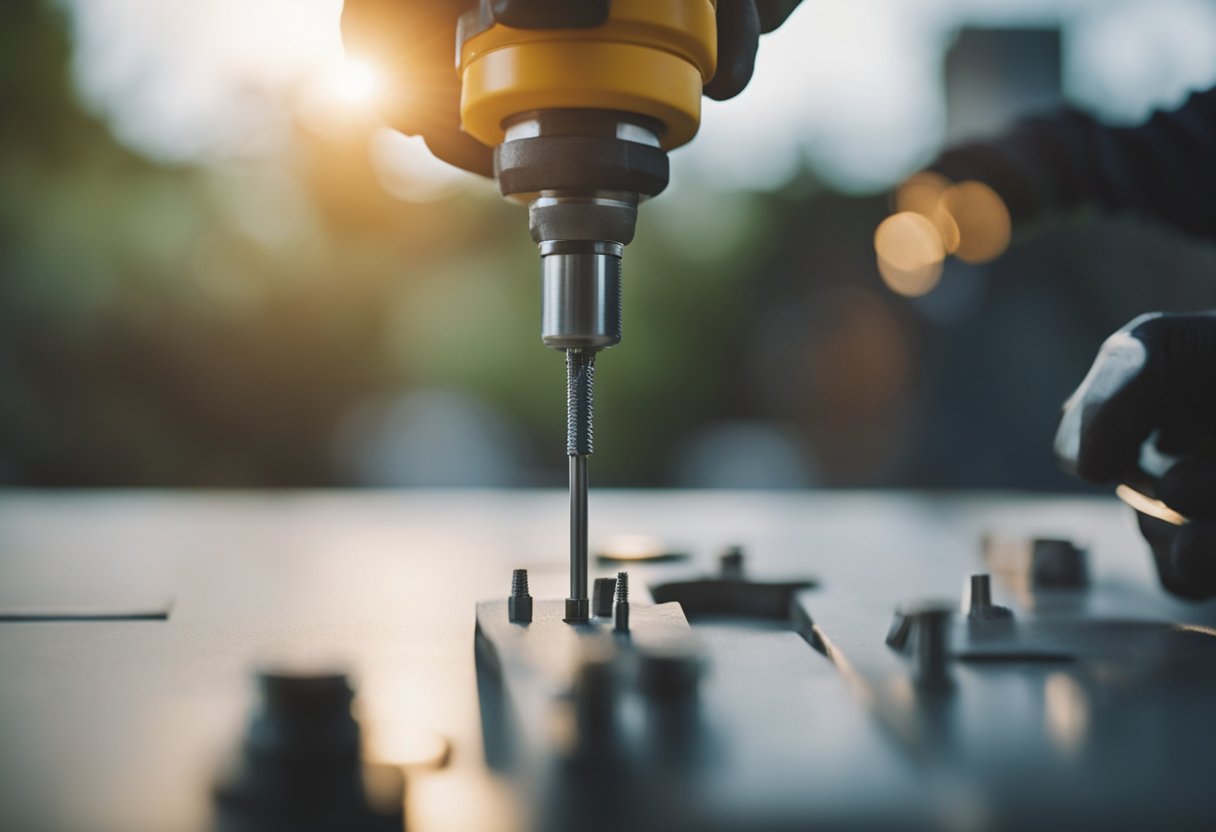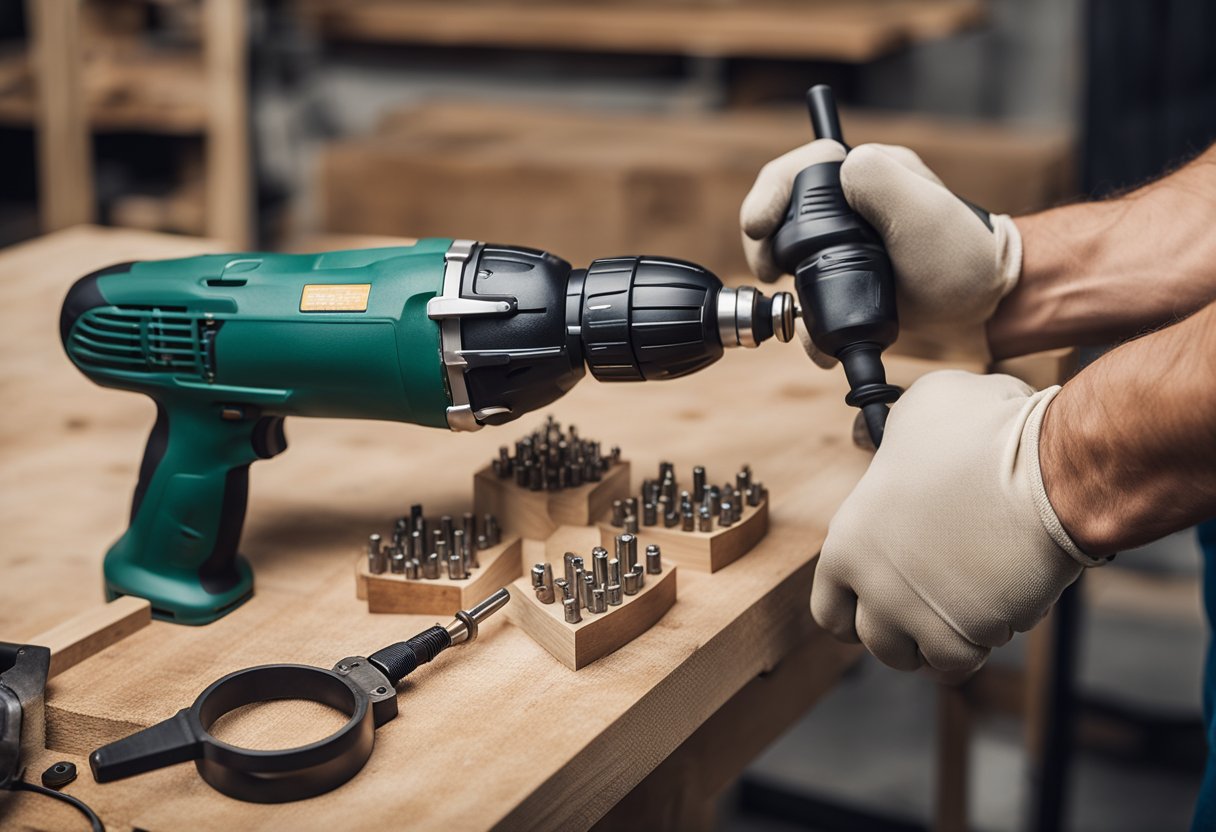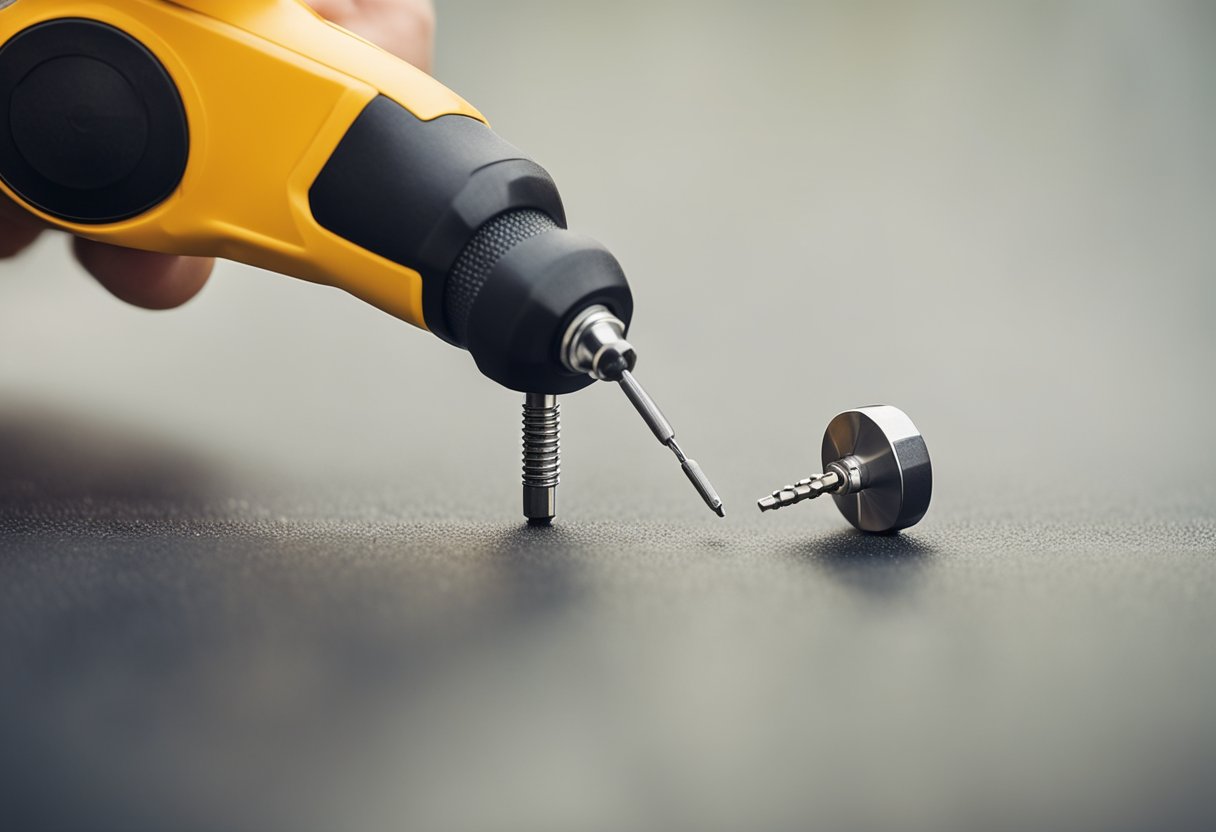I am going to share some tips on how to drill a hole without a drill. Drilling a hole is a common task that is required in many DIY projects. However, not everyone has access to a drill or wants to invest in one. Fortunately, there are several alternative tools and techniques that can be used to drill a hole without a drill.
Before we dive into the alternative methods for drilling, it’s important to understand the basics of drilling. Drilling involves creating a hole in a material by rotating a drill bit. The drill bit is typically powered by a drill machine, but there are other tools that can be used to rotate the bit. Understanding the mechanics of drilling will help you to choose the right tool and technique for the job.
Key Takeaways
- There are several alternative tools and techniques that can be used to drill a hole without a drill.
- Understanding the basics of drilling is important before attempting to drill a hole without a drill.
- Safety precautions and tips should be followed when drilling without a drill.
Understanding the Basics of Drilling
As a DIY enthusiast, I know that drilling is an essential part of many projects. Whether you’re a professional or a hobbyist, you need to be familiar with the basics of drilling to achieve the desired results. In this section, I will cover the fundamentals of drilling, including the different types of drills and drill bits.
Types of Drills
There are several types of drills, including hand drills, electric drills, and drill presses. Hand drills are the simplest and most common type of drill. They are a hand-operated tool that uses a simple mechanism to rotate the drill bit. Electric drills, on the other hand, are powered by electricity and are more powerful than hand drills. They come in corded and cordless varieties and are available in different sizes and shapes. Drill presses are stationary tools that use a motor to rotate the drill bit. They are ideal for precision drilling and are commonly used in industrial settings.
Drill Bits
Drill bits are the cutting tools that are used to create holes in different materials. They come in various shapes and sizes, and each type of drill bit is designed for a specific purpose. For example, twist drill bits are the most common type of drill bit and are suitable for drilling into wood, plastic, and metal. Spade bits, on the other hand, are ideal for drilling large holes in wood. For drilling into concrete or masonry, masonry bits are the best option.
In conclusion, understanding the basics of drilling is essential for anyone who wants to undertake DIY projects. By knowing the different types of drills and drill bits, you can choose the right tool for the job and achieve the desired results.
Alternative Tools for Drilling
When you don’t have a drill, there are still several tools that can be used to drill a hole. Here are some alternative tools for drilling:
Screwdriver
A screwdriver can be used to drill small holes in soft materials such as wood or plastic. Simply place the tip of the screwdriver where you want the hole and apply pressure while twisting it back and forth. This method can be time-consuming and may not be suitable for larger holes or harder materials.
Bow Drill
A bow drill is a simple hand tool that can be used to drill holes in wood or other soft materials. It consists of a wooden bow, a spindle, and a fireboard. By rotating the bow, the spindle is spun against the fireboard, creating friction that generates heat and eventually creates a hole. This method is time-consuming and requires some practice to master.
Chisel
A chisel can be used to cut away the material and create a hole. Place the chisel perpendicular to the wood close to where the hole is needed. Strike the back of the chisel with a hammer creating a cut in the wood. Repeat the process until the hole is the desired size. This method is suitable for larger holes and harder materials.
Hand Tools
Various hand tools such as awls, punches, and nail sets can be used to create small holes in soft materials. These tools are easy to use and can be found in most toolboxes.
Egg-Beater Drill
An egg-beater drill is a hand-powered drill that uses a gear mechanism to rotate the drill bit. It is suitable for drilling small holes in wood or metal. Simply insert the drill bit into the chuck and turn the handle to rotate the bit. This method is slower than using a power drill but can be useful in situations where a power source is not available.
Bit & Brace
A bit and brace is a hand-powered drill that uses a crank mechanism to rotate the drill bit. It is suitable for drilling larger holes in wood or metal. Simply insert the drill bit into the chuck and turn the crank to rotate the bit. This method is slower than using a power drill but can be useful in situations where a power source is not available.
In conclusion, there are several alternative tools that can be used to drill a hole when a power drill is not available. However, these methods may be time-consuming and may not be suitable for larger or harder materials.
Techniques for Drilling Without a Drill
https://www.youtube.com/watch?v=eSJtG947ZPk&embed=true
As a DIY enthusiast, I know firsthand that sometimes we don’t have access to a drill or simply don’t want to use one. But don’t worry, there are several techniques you can use to drill a hole without a drill. Here are some of the most effective methods:
Using a Nail
One of the easiest ways to drill a hole without a drill is to use a nail. Simply hold the nail against the spot where you want to make the hole, and hit it with a hammer until it goes through the material. Be sure to hold the nail perpendicular to the surface to ensure a straight hole. You can also use an awl instead of a nail, which is a pointed tool used for making small holes.
Hammering a Self-Driving Screw
Another way to drill a hole without a drill is to use a self-driving screw. These screws have a pointed tip that allows you to screw them directly into the material without the need for a pilot hole. To use a self-driving screw, hold it against the spot where you want to make the hole, and hit it with a hammer until it goes through the material.
Using a String and a Cutting Material
If you need to make a larger hole, you can use a string and a cutting material. Tie a knot in the string and place it against the material where you want to make the hole. Hold the string in place with one hand, and use the other hand to saw back and forth with the cutting material. This will gradually cut through the material and create a hole.
Using a Chisel and a Hammer
If you need to make a square or rectangular hole, you can use a chisel and a hammer. Hold the chisel against the material where you want to make the hole, and hit it with a hammer until it cuts through the material. Be sure to hold the chisel perpendicular to the surface to ensure a straight cut.
These are just a few of the techniques you can use to drill a hole without a drill. With a little practice, you can become proficient in making holes without a power tool.
Working with Different Materials
https://www.youtube.com/watch?v=5SZA03DVITA&embed=true
When it comes to drilling holes without a drill, it’s important to consider the type of material you’re working with. Different materials require different techniques and tools to get the job done. Here are some tips for working with common materials:
Wood
Wood is one of the easiest materials to work with when it comes to drilling holes without a drill. One method involves using a nail or an awl to create a starting point for the hole. Simply hammer the nail or awl into the wood and then remove it, creating a small hole that can be widened with a larger tool. Another option is to use a hole saw, which can be attached to a hand drill or power drill. This tool is especially useful when drilling larger holes in wooden furniture or other objects.
Metal
Drilling holes in metal without a drill can be a bit trickier, but it’s still possible with the right tools and techniques. One method involves using a hole punch plier, which is designed specifically for cutting holes into sheet metal. Another option is to use a metal file or a rotary tool with a cutting wheel attachment. It’s important to note that metal can get quite hot when being drilled, so it’s important to use proper safety precautions and work in a well-ventilated area.
Heat
When working with metal, it’s important to keep in mind that heat can affect the drilling process. If the metal gets too hot, it can become warped or damaged. To prevent this from happening, it’s important to use a lubricant such as oil or water to keep the metal cool while drilling. Additionally, it’s important to work slowly and carefully, taking breaks as needed to prevent overheating.
Hardwood
Hardwood can be more difficult to drill than softer woods, but it’s still possible with the right tools and techniques. One method involves using a spade bit, which can be attached to a hand drill or power drill. It’s important to work slowly and carefully when drilling hardwood, as it can be prone to splintering or cracking.
Wooden Sled
When drilling holes in a wooden sled, it’s important to take into account the thickness of the wood and the size of the hole needed. One method involves using a hole saw, which can be attached to a hand drill or power drill. It’s important to work slowly and carefully when drilling through the sled, as it can be prone to cracking or splintering.
Wooden Furniture
When drilling holes in wooden furniture, it’s important to take into account the type of wood and the size of the hole needed. One method involves using a spade bit, which can be attached to a hand drill or power drill. Another option is to use a hole saw, which can be useful for larger holes. It’s important to work slowly and carefully when drilling through wooden furniture, as it can be prone to splintering or cracking.
Safety Precautions and Tips
As with any DIY project, safety should always be a top priority when drilling a hole without a drill. Here are some tips to ensure a safe and successful project:
- Wear protective gear such as safety goggles, gloves, and a dust mask to avoid any injuries or inhalation of debris.
- Secure your workpiece using a clamp or other holding device to prevent it from moving or spinning during drilling. This will also ensure accuracy and prevent wobbling or uneven drilling.
- Use a drill guide or portable drill guide to help keep your drill bit straight and prevent it from wandering off course. This will also help prevent damage to your workpiece and ensure a clean, precise hole.
- Always maintain a firm grip on the main handle of your tool, and use a side handle if available for added stability and control.
- Use a turning handle or crank to rotate your drill bit slowly and steadily through your workpiece. Avoid applying too much pressure or forcing the bit, as this can cause it to break or bend.
- Use cutting tips appropriate for the material you are drilling through. For example, use a wood bit for wood and a masonry bit for concrete. This will ensure a clean and efficient cut.
- Use a divider caliper wing to measure and mark the exact location of your hole before drilling. This will ensure accuracy and prevent any mistakes.
By following these safety precautions and tips, you can confidently and successfully drill a hole without a drill.
Unconventional Methods for Drilling
https://www.youtube.com/watch?v=mZiymA26cEk&embed=true
When it comes to drilling, we often think of using a drill machine or a drill bit. However, there are several unconventional methods for drilling that can come in handy in certain situations. In this section, I will discuss some of these methods that you can use to drill a hole without a drill.
Burning
Burning is a technique that can be used to drill a hole in wood or other materials. To do this, you will need a red-hot metal rod. Heat the rod until it is red hot and then place it on the material where you want to drill the hole. The heat will burn through the material, creating a hole. This method is not recommended for materials that are sensitive to heat, as it can damage them.
Fire Drill
The fire drill method is another way to drill a hole in wood. To do this, you will need a wooden board, a spindle, and a bow. Cut a small hole in the board and place the spindle in it. Use the bow to spin the spindle rapidly, which will create friction and generate heat. Keep spinning the spindle until it burns through the wood, creating a hole.
Burning the Wood
Another way to drill a hole in wood is to burn it. To do this, you will need a small flame, such as a lighter or a candle. Hold the flame against the wood where you want to drill the hole and move it around in a circular motion. The heat from the flame will burn through the wood, creating a hole. This method is not recommended for materials that are sensitive to heat, as it can damage them.
Chipping Away
Chipping away is a technique that can be used to drill a hole in stone or concrete. To do this, you will need a hammer and a chisel. Use the chisel to chip away at the material where you want to drill the hole. Keep chipping away until you create a hole that is the desired size.
Hollow Metal Punch
A hollow metal punch is a tool that can be used to drill a hole in metal. To use this tool, you will need to place it on the metal where you want to drill the hole and strike it with a hammer. The punch will cut through the metal, creating a hole. This method is best suited for thin sheets of metal.
Use an Awl
An awl is a pointed tool that can be used to drill a hole in leather or other soft materials. To use this tool, simply place the point of the awl where you want to drill the hole and apply pressure. Twist the awl back and forth to create a hole that is the desired size.
Glue
In some cases, you can use glue to create a hole. To do this, you will need to apply a small amount of glue to the material where you want to drill the hole. Wait for the glue to dry and then use a sharp object, such as a needle or a pin, to poke a hole through the glue. This method is best suited for materials that are not too thick.
Conclusion
https://www.youtube.com/watch?v=TwAOfYY9nKw&embed=true
In conclusion, there are several methods available to drill a hole without a drill. These methods are particularly useful when you don’t have a drill at hand or when you need to make a hole in a material that is difficult to drill.
Some of the methods we discussed include using a screwdriver and hammer, hammering a nail into the material, using a chisel and hammer, using a bow drill, and using a red-hot metal rod. Each of these methods has its own advantages and disadvantages, and the choice of method will depend on several factors such as the material you’re working with, the size of the hole you need, and the tools you have at hand.
It’s important to note that while these methods can be effective, they require a certain level of skill and practice to execute properly. Additionally, some of these methods may not be suitable for certain materials or may not produce the same level of precision as a drill.
Overall, if you need to drill a hole without a drill, it’s worth exploring these methods and practicing them to see which one works best for you. With a bit of patience and practice, you can achieve good results and complete your DIY projects with ease.
Frequently Asked Questions
What are some alternatives to using a drill to make a hole?
If you don’t have a drill or don’t want to use one, there are several alternative ways to cut holes in various materials. Some of these methods include using an awl, a hole saw, a rotary tool, a hand drill, a punch, or a chisel. Each method has its own advantages and disadvantages, so choose the one that suits your needs and skills.
How can I make a hole in wood without a drill?
There are several ways to make a hole in wood without a drill. You can use an awl, a hole saw, a spade bit, a chisel, or a hand drill. Some of these methods require more skill and patience than others, so choose the one that suits your experience level and the size of the hole you need to make.
How can I make a hole in metal without a drill?
Making a hole in metal without a drill can be challenging, but it’s possible. Some of the methods you can use include using a punch, a hammer and nail, a rotary tool, or a hole saw. Each method has its own advantages and disadvantages, so choose the one that suits your needs and skills.
What household items can I use to make a hole?
If you don’t have any tools at hand, you can still make a hole using some household items. Some of the items you can use include a nail, a screwdriver, a knife, a pair of scissors, or a heated metal rod. However, keep in mind that using these items can be dangerous and may not produce the best results.
Is it possible to drill a hole without a drill bit?
Yes, it is possible to drill a hole without a drill bit. Some of the methods you can use include using a screwdriver, a knife, a heated metal rod, or a rotary tool. However, keep in mind that these methods may not produce the best results and can be dangerous if not used properly.
How do I make a hole in brick without a drill?
Making a hole in brick without a drill can be challenging, but it’s possible. Some of the methods you can use include using a hammer and chisel, a rotary tool, or a carbide-tipped masonry bit. Each method has its own advantages and disadvantages, so choose the one that suits your needs and skills.

Hi, I’m Sal Muller of Tooltrip.com. My DIY experience led me to understand essential power tools for home projects. Tooltrip.com guides enthusiasts and professionals in choosing right tools for any job. I provide concise top tool reviews for easier, efficient DIY.






